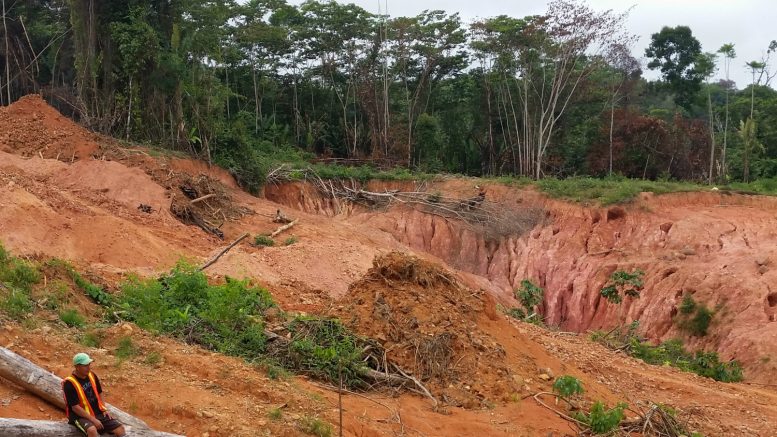Guyana Goldstrike (TSXV: GYA) has completed preliminary mapping, trenching and sampling at the Paunch area on its Marudi gold project in Guyana’s Guiana gold belt — phase one of its 2018 exploration program.
The Paunch area is 1 km north of Goldstrike’s Marudi camp and accessible by road. It is 1.5 km north of the company’s Mazoa Hill gold target and 1 km east of its Marudi North zone. So far, the company has dug 166 metres across 12 trenches at Paunch.
The company is awaiting results from its trenching program and will then complete an aeromagnetic survey with radar imaging and radiometrics — the first airborne survey ever done on the property. Exploration work at Marudi so far has only covered 5% of the 56 sq. km property.
Guyana Goldstrike vice-president of exploration Locke Goldsmith says this work should help the company prospect its land.
“The down payment has been made and the geophysical equipment is in Guyana at the helicopter base,” Goldsmith says during a telephone interview with The Northern Miner.
“Right now we’re just waiting for the best weather,” he adds, noting that thunderstorms can be an issue.

Artisanal miners have mined alluvial gold from creeks on the property since the 1930s. Goldstrike now collects a 10% royalty from alluvial miners on their property. Credit: Guyana Goldstrike.
The company will look to drill the property later this year, but not before completing more preliminary exploration. Locke says its drilling will depend on how many targets the exploration work yields.
The company has not yet drilled Marudi, but tabled a resource estimate for Mazoa Hill in late 2017 based on drilling by previous operators. Mazoa Hill contains 4.4 million indicated tonnes grading 1.8 grams gold per tonne for 259,100 oz. gold, as well as 1.65 million inferred tonnes at 1.6 grams gold for 86,200 oz. gold.
The resource is based on trenching and 63 drill holes. The mineralization has been traced along 300 metres of northwest strike, 150 metres wide, and to 250 metres below surface. The zone has mineralized quartzite but is covered in a layer of gold-bearing saprolite up to 30 metres thick.
Marudi North is a 0.4 sq. km target located 100 metres from Goldstrike’s main camp. From 1946 to 2004, three different operators drilled 49 holes into the zone for close to 10,000 metres. Goldstrike has data for 35 of those holes, but could not interpret the morphology with enough confidence to support a resource estimate.
Guyana Goldstrike’s exploration program is being funded by a $3.2-million investment from the Zijin Mining Group, which made a strategic investment in the company in February via its wholly owned subsidiary Gold Mountains Asset Management.
“Zijin thought this property was severely underexplored,” Guyana Goldstrike president and CEO Peter Berdusco says. “They did the $3.2 million based on completing all of our trenching and our first phase of drilling, and potentially some of our second phase.”
Peter says the money will keep Goldstrike funded into 2019, although he notes that as a junior explorer his company never stops having financing conversations. In a technical report published by the company in December 2017, Goldstrike pegged its 2018 exploration budget at US$1.57 million.
Artisanal miners have mined alluvial gold from creeks on the property since the 1930s. Goldstrike has an agreement with the six current alluvial mining groups wherein those groups are allowed to continue to operate on the property in exchange for a 10% royalty on gold they recover. Over the past year, Goldstrike has collected $250,000 in royalties.
“So that’s a nice little bonus for us, because the interest of the company isn’t really the alluvials or creeks,” Berdusco says.
When Goldstrike starts drilling the property, it will allow the alluvial miners to continue working because “they really aren’t in the way.”
The company holds an 18-year mining licence for the Marudi project. The project’s previous operator Romanex Exploration applied to convert its prospecting licence to a 20-year mining licence in June 2003. The Guyanese government granted the licence in April 2009. The licence can be renewed for another seven years or the life of the deposit — whichever is shorter. Formerly named Swift Resources, Guyana Goldstrike acquired Romanex in March 2017.

Guyana Goldstrike employees work the south-facing Paunch area trench. Credit: Guyana Goldstrike.
“We could mine today,” Berdusco says. “We have a mining licence and we are of the opinion that we should exploit it.”
As a result, the company says it is “exploring strategies” on mining gold in the saprolite at Mazoa Hill, which “is simply overburden.” It is considering starting a feasibility study on the saprolite this year.
In February, the company formed the Gold and Silver Ethereum Strategic Alliance with Canamex Gold (TSX: CSQ), Cabral Gold (TSXV: CBR), Arizona Silver (TSXV: AZS) and Altamira Gold (TSXV: ALTA). The concept is to issue a crypto-token redeemable for royalties on gold from Goldstrike’s property. For example, if Goldstrike sold a royalty worth 5,000 oz. gold, the buyer would advance Goldstrike the money, leaving Goldstrike with an obligation to deliver the gold sometime in the future.
“We’re always looking for opportunities to finance that are attractive to the shareholders of the company,” Berdusco says. “We have an opportunity through this alliance to fund the company through financing that is not equity based.”
At press time, shares of Guyana Goldstrike traded at 27¢ per share within a 52-week range of 14¢ to 38¢. The company has a $14-million market capitalization.


Be the first to comment on "Guyana Goldstrike trenches Marudi ahead of drilling"